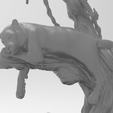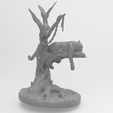Black panther
From Wikipedia, the free encyclopedia
Jump to navigationJump to search
For the U.S. political party, see Black Panther Party. For the comic-book character, see Black Panther (Marvel Comics). For other uses, see Black Panther (disambiguation).
A melanistic Indian leopard in Nagarhole National Park
A melanistic jaguar at the Henry Doorly Zoo
A black panther is the melanistic colour variant of any Panthera, particularly of the leopard (P. pardus) in Asia and Africa, and the jaguar (P. onca) in the Americas.
Contents
1 History
2 Melanism in the genus Panthera
2.1 Leopard
2.2 Jaguar
3 Unconfirmed cases
3.1 Cougar
3.2 Australia
4 Culture and literature
5 See also
6 References
7 External links
History
In 1788, Jean-Claude Delamétherie described a black panther, which was kept in the Tower of London and had been brought from Bengal.[1] In 1794, Friedrich Albrecht Anton Meyer proposed the scientific name Felis fusca for this individual.[2]
Melanism in the genus Panthera
Melanism in the jaguar is conferred by a dominant allele, and in the leopard by a recessive allele.[3] Melanistic and non-melanistic animals can be littermates. It is thought that melanism confers a selective advantage under certain conditions since it is more common in regions of dense forest, where light levels are lower. Preliminary studies also suggest that melanism might be linked to beneficial mutations in the immune system.[4] Due to the excess black pigments, the typical spotted markings are present, but hidden, which is called "ghost rosettes".[5]
Leopard
A melanistic leopard from the Out of Africa Wildlife Park in Camp Verde, Arizona
Markings on a female black leopard at the Rhino and Lion Nature Reserve, Kromdraai, South Africa
The taxonomic status of captive black leopards and the extent of hybridization between the Javan leopard (Panthera pardus melas) and other leopard subspecies is uncertain. Therefore, coordinated breeding programs for black leopards do not exist in European and North American zoos.[6] Black leopards occupy space needed for breeding endangered leopard subspecies and are not kept within the North American Species Survival Plan.[7][8]
Frequency of melanism appears to be approximately 11% over the leopard's range. Data on the distribution of leopard populations indicates that melanism occurs in five subspecies in the wild: Javan leopard, African leopard (P. p. pardus), Indian leopard (P. p. fusca), Indochinese leopard (P. p. delacouri), Sri Lankan leopard (P. p. kotiya).[9] Black leopards are common in the equatorial rainforest of the Malay Peninsula and the tropical rainforest on the slopes of some African mountains such as Mount Kenya.[10] Melanistic leopards are common in Java, and are reported from densely forested areas in southwestern China, Myanmar, Assam and Nepal, from Travancore and some parts of southern India where they may be more numerous than spotted leopards.[11]
In North Africa, dark leopards have been reported in the Atlas Mountains.[12] A black leopard was reported from the alpine zone of Mount Kenya.[13] Black leopards also occur in Kenya's Aberdare Mountains and in Ethiopia. Unconfirmed reports of black leopards exist also in South Africa and in northern Iran. Based on records from camera traps, melanistic leopards occur foremost in tropical and subtropical moist forests.[9] In 2019, a black leopard was recorded in Kenya's Laikipia County.[14][15][16][17]
Two black Amur leopard (P. p. orientalis) cubs were born in zoos.[18][19]
A pseudo-melanistic leopard has a normal background color, but the spots are more densely packed than normal and merge to obscure the golden-brown background color. Any spots on the flanks and limbs that have not merged into the mass of swirls and stripes are unusually small and discrete, rather than forming rosettes. The face and underparts are paler and dappled like those of ordinary spotted leopards.[20]
Jaguar
A melanistic jaguar
In jaguars, the melanism allele is dominant. Consequently, black jaguars may produce either black or spotted cubs, but a pair of spotted jaguars can only produce spotted cubs. Individuals with two copies of the allele are darker (the black background colour is denser) than ones with just one copy, whose background colour may appear to be dark charcoal rather than black.
The black jaguar was considered a separate species by indigenous peoples. English naturalist W. H. Hudson wrote:
The jaguar is a beautiful creature, the ground-colour of the fur a rich golden-red tan, abundantly marked with black rings, enclosing one or two small spots within. This is the typical colouring and it varies little in the temperate regions; in the hot region the Indians recognise three strongly marked varieties, which they regard as distinct species – the one described; the smaller jaguar, less aquatic in his habits and marked with spots, not rings; and, thirdly, the black variety. They scout the notion that their terrible "black tiger" is a mere melanic variation, like the black leopard of the Old World and the wild black rabbit. They regard it as wholly distinct, and affirm that it is larger and much more dangerous than the spotted jaguar; that they recognise it by its cry; that it belongs to the terra firma rather than to the water-side; finally, that black pairs with black, and that the cubs are invariably black. Nevertheless, naturalists have been obliged to make it specifically one with Felis onca [Panthera onca], the familiar spotted jaguar, since, when stripped of its hide, it is found to be anatomically as much like that beast as the black is like the spotted leopard.[21]
Unconfirmed cases
Cougar
There are no authenticated cases of truly melanistic cougars. Melanistic cougars have never been photographed or killed in the wild, and none have ever been bred. Unconfirmed sightings, known as the "North American black panther", are currently attributed to errors in species identification by non-experts, and by the mimetic exaggeration of size. Black panthers in the American Southeast feature prominently in Choctaw folklore where, along with the owl, they are often thought to symbolize Death.
In his Histoire Naturelle (1749), French naturalist Georges-Louis Leclerc, Comte de Buffon, wrote of the "Black Cougar":[22]
M. de la Borde, King’s physician at Cayenne, informs me, that in the [South American] Continent there are three species of rapacious animals; that the first is the jaguar, which is called the tiger; that the second is the couguar [sic], called the red tiger, on account of the uniform redness of his hair; that the jaguar is of the size of a large bull-dog, and weighs about 200 pounds [90 kg]; that the cougar is smaller, less dangerous, and not so frequent in the neighbourhood of Cayenne as the jaguar; and that both these animals take six years in acquiring their full growth. He adds, that there is a third species in these countries, called the black tiger, of which we have given a figure under the appellation of the black cougar. The head is pretty similar to that of the common cougar; but the animal has long black hair, and likewise a long tail, with strong whiskers. He weighs not much above forty pounds [18 kg]. The female brings forth her young in the hollows of old trees.
This "black cougar" was most likely a margay or ocelot, which are under 18 kg (40 lb) in weight, live in trees, and do have melanistic phases.
Another description of a black cougar[23] was provided by Thomas Pennant:
Black tiger, or cat, with the head black, sides, fore part of the legs, and the tail, covered with short and very glossy hairs, of a dusky colour, sometimes spotted with black, but generally plain: Upper lips white: At the corner of the mouth a black spot: Long hairs above each eye, and long whiskers on the upper lip: Lower lip, throat, belly and the inside of the legs, whitish, or very pale ash-colour: Paws white: Ears pointed: Grows to the size of a heifer of a year old: Has vast strength in its limbs.-- Inhabits Brasil and Guiana: Is a cruel and fierce beast; much dreaded by the Indians; but happily is a scarce species.
According to his translator Smellie (1781), the description was taken from two black jaguars exhibited in London some years previously.
Australia
Black panther sightings are frequently recorded in rural Victoria and New South Wales,[24] and Western Australia. The Australian "phantom panthers" are said to be responsible for the disappearances and deaths of numerous cats, dogs and livestock.
Animal X Natural Mysteries Unit led an investigation into the phantom panther. Mike Williams, a local researcher, said he had sent feces and hair found by locals to labs for analysis, which identified it as feces from dogs that had feasted on swamp wallaby, and hair from a domestic cat. Williams said he also had known leopard feces and hair collected from a private zoo tested by one of the same labs, but that these samples came back with the same results of dog feces and domestic cat hair. This indicated the lab incapable of distinguishing between leopard hairs and those of domestic animals, casting doubt on the previous findings. The lab used was not identified in the episode.[25]
Culture and literature
Bagheera in The Jungle Book by Rudyard Kipling is an Indian panther that mentors the human character Mowgli.[26]
The Black Panther Party was an African-American political organization.
The Black Panther is a Marvel Comics superhero based in the fictional African country of Wakanda.
The NFL football team the Carolina Panthers is named after the black panther, with a logo resembling the animal.
The National Rugby League team the Penrith Panthers is named after the black panther, with a logo of the animal.
See also
Black cat
Black tiger (animal)
Keimu
Pogeyan
White panther

/https://fbi.cults3d.com/uploaders/14219689/illustration-file/c9c09cb3-4b13-4c59-b9c6-1a18946e0fc9/untitled.245.png)









